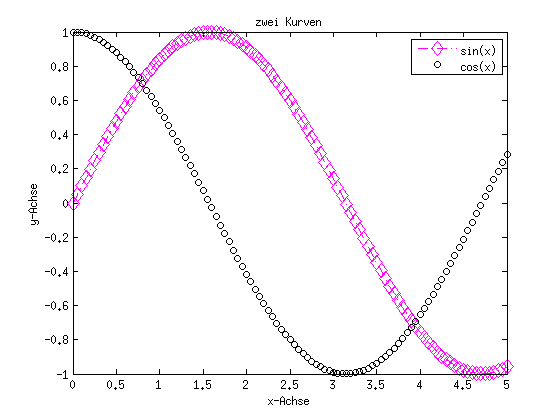Contents
Graphik Teil I
clear
close all
Einfache Kurvenplots:
x = 0:0.05:5;
y=sin(x.^2);
plot(x,y)
% show graph window
shg
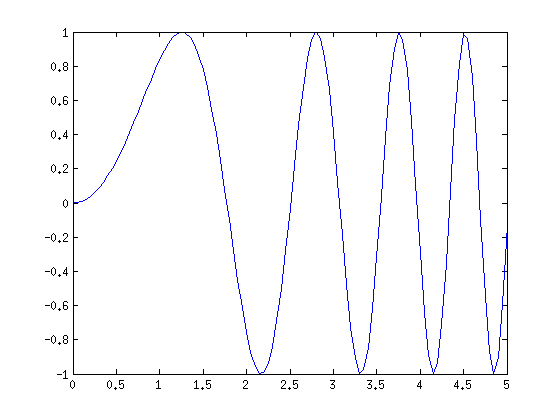
Mehrere Kurven in einer Graphik:
hold, hold on, hold off
clc clf plot(x,y) % Graphik festhalten hold on plot(x,cos(x)) % Graphik wieder freigeben hold off
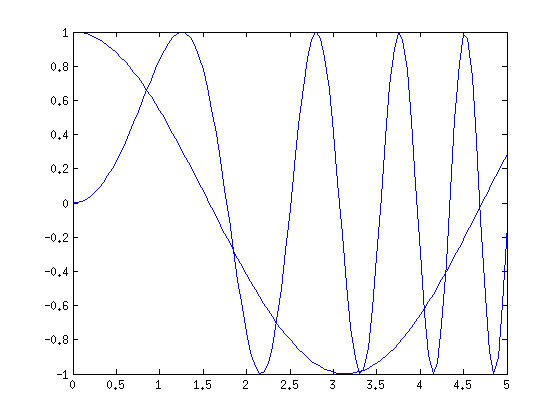
Einstellungen I
- Farbe der Linien - Art der Linien . nur die Punkte einzeichnen . gepunktet, durchgezogen, gestrichelt
plot(x,y,'r--') hold on plot(x,cos(x),'g+') hold off clc help plot
PLOT Linear plot.
PLOT(X,Y) plots vector Y versus vector X. If X or Y is a matrix,
then the vector is plotted versus the rows or columns of the matrix,
whichever line up. If X is a scalar and Y is a vector, disconnected
line objects are created and plotted as discrete points vertically at
X.
PLOT(Y) plots the columns of Y versus their index.
If Y is complex, PLOT(Y) is equivalent to PLOT(real(Y),imag(Y)).
In all other uses of PLOT, the imaginary part is ignored.
Various line types, plot symbols and colors may be obtained with
PLOT(X,Y,S) where S is a character string made from one element
from any or all the following 3 columns:
b blue . point - solid
g green o circle : dotted
r red x x-mark -. dashdot
c cyan + plus -- dashed
m magenta * star (none) no line
y yellow s square
k black d diamond
w white v triangle (down)
^ triangle (up)
< triangle (left)
> triangle (right)
p pentagram
h hexagram
For example, PLOT(X,Y,'c+:') plots a cyan dotted line with a plus
at each data point; PLOT(X,Y,'bd') plots blue diamond at each data
point but does not draw any line.
PLOT(X1,Y1,S1,X2,Y2,S2,X3,Y3,S3,...) combines the plots defined by
the (X,Y,S) triples, where the X's and Y's are vectors or matrices
and the S's are strings.
For example, PLOT(X,Y,'y-',X,Y,'go') plots the data twice, with a
solid yellow line interpolating green circles at the data points.
The PLOT command, if no color is specified, makes automatic use of
the colors specified by the axes ColorOrder property. By default,
PLOT cycles through the colors in the ColorOrder property. For
monochrome systems, PLOT cycles over the axes LineStyleOrder property.
Note that RGB colors in the ColorOrder property may differ from
similarly-named colors in the (X,Y,S) triples. For example, the
second axes ColorOrder property is medium green with RGB [0 .5 0],
while PLOT(X,Y,'g') plots a green line with RGB [0 1 0].
If you do not specify a marker type, PLOT uses no marker.
If you do not specify a line style, PLOT uses a solid line.
PLOT(AX,...) plots into the axes with handle AX.
PLOT returns a column vector of handles to lineseries objects, one
handle per plotted line.
The X,Y pairs, or X,Y,S triples, can be followed by
parameter/value pairs to specify additional properties
of the lines. For example, PLOT(X,Y,'LineWidth',2,'Color',[.6 0 0])
will create a plot with a dark red line width of 2 points.
Example
x = -pi:pi/10:pi;
y = tan(sin(x)) - sin(tan(x));
plot(x,y,'--rs','LineWidth',2,...
'MarkerEdgeColor','k',...
'MarkerFaceColor','g',...
'MarkerSize',10)
See also PLOTTOOLS, SEMILOGX, SEMILOGY, LOGLOG, PLOTYY, PLOT3, GRID,
TITLE, XLABEL, YLABEL, AXIS, AXES, HOLD, LEGEND, SUBPLOT, SCATTER.
Overloaded methods:
timeseries/plot
dspdata.plot
Reference page in Help browser
doc plot
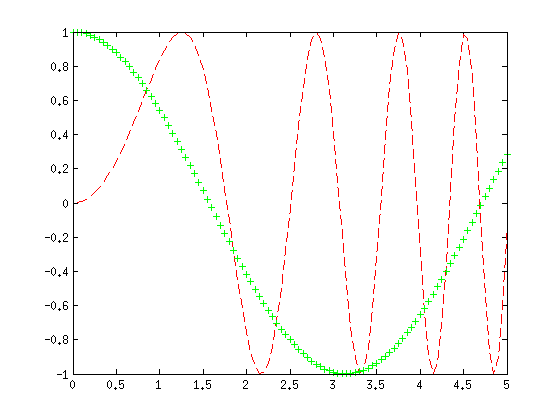
Dicke der Linien
plot(x,y,'LineWidth',10)
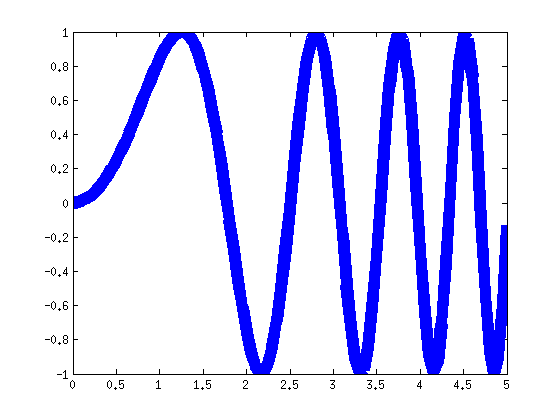
Groesse der Markierungen
plot(x,y,'*-','Markersize',20)
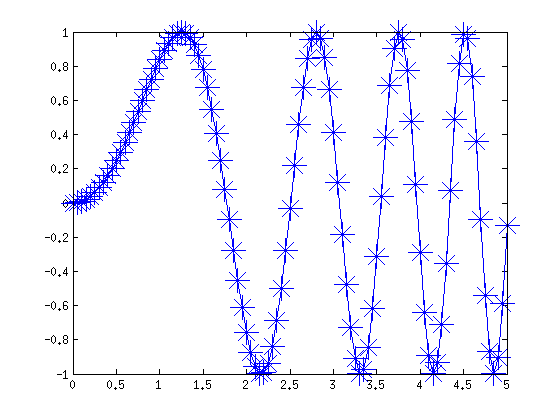
Art der Markierung
plot(x,y,'s-','Markersize',20,'LineWidth',2,'MarkerFaceColor','g')
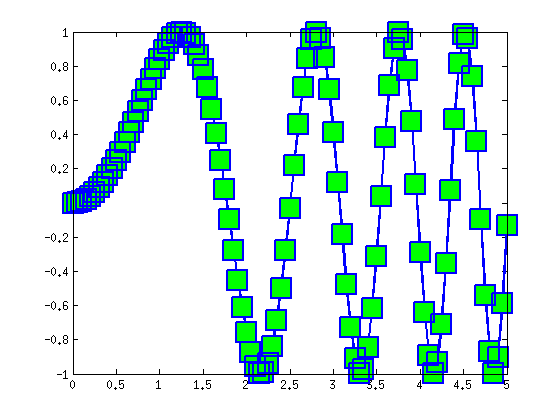
Gestaltung der Markierungen
plot(x,y,'s-','Markersize',20,'MarkerFaceColor','g','MarkerEdgeColor','r')
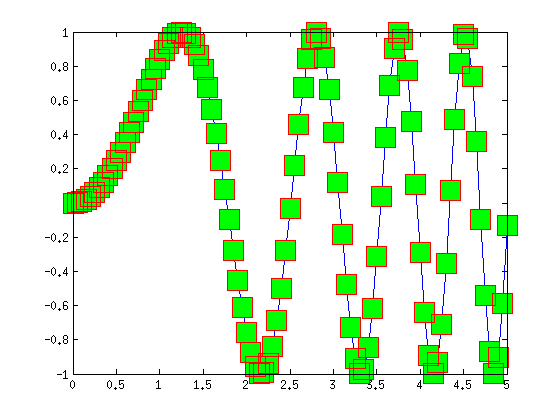
Mehrere Plots in einem Aufruf von plot
default: automatische Farbwahl
plot(x,sin(x),x,cos(x))
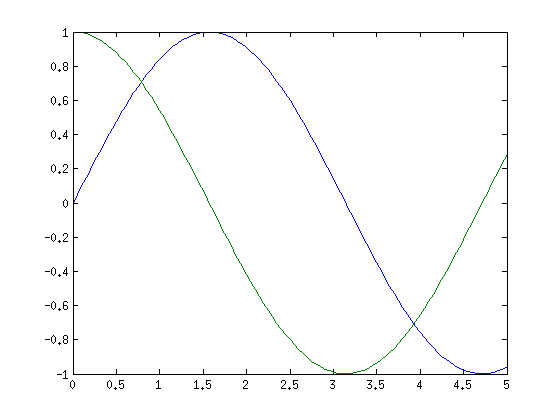
Farb- und Markereinstellung fuer jede Kurve
plot(x,sin(x),'m-.',x,cos(x),'ko')
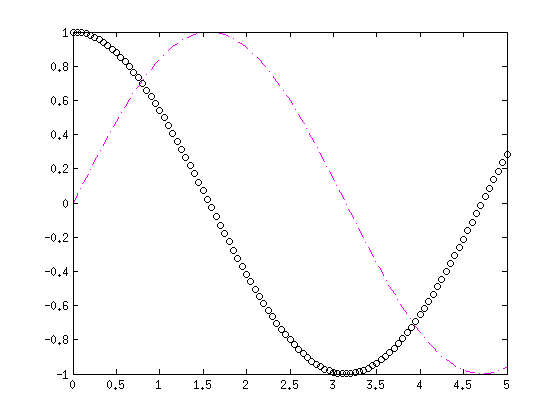
Einstellungen II
get: Anzeige der Einstellungen
h=plot(x,sin(x),'m-.',x,cos(x),'ko')
h = 174.0095 175.0046
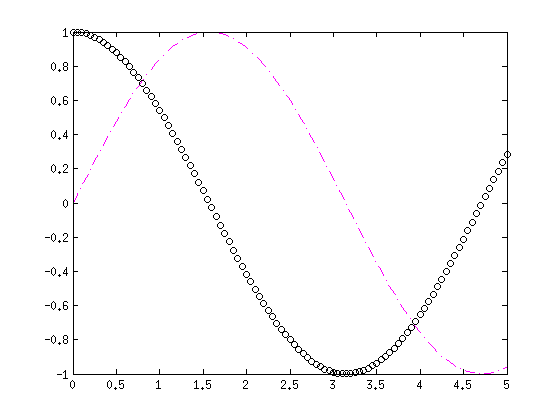
get(h(1)) set(h(1),'Marker','d','MarkerSize',10)
DisplayName: ''
Annotation: [1x1 hg.Annotation]
Color: [1 0 1]
LineStyle: '-.'
LineWidth: 0.5000
Marker: 'none'
MarkerSize: 6
MarkerEdgeColor: 'auto'
MarkerFaceColor: 'none'
XData: [1x101 double]
YData: [1x101 double]
ZData: [1x0 double]
BeingDeleted: 'off'
ButtonDownFcn: []
Children: [0x1 double]
Clipping: 'on'
CreateFcn: []
DeleteFcn: []
BusyAction: 'queue'
HandleVisibility: 'on'
HitTest: 'on'
Interruptible: 'on'
Selected: 'off'
SelectionHighlight: 'on'
Tag: ''
Type: 'line'
UIContextMenu: []
UserData: []
Visible: 'on'
Parent: 173.0037
XDataMode: 'manual'
XDataSource: ''
YDataSource: ''
ZDataSource: ''
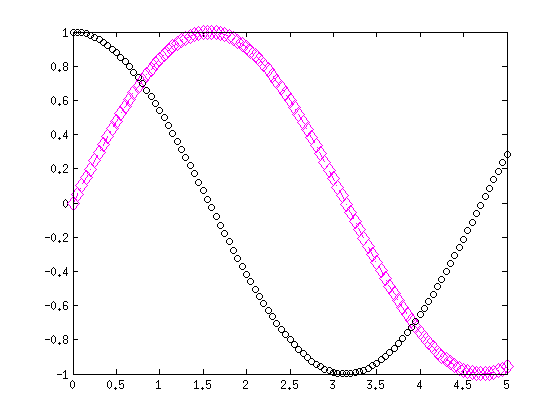
Beschriftung der Graphik
- Ueberschrift (Titel)
- Achsen
- Legende (ausschalten mit legend off)title('zwei Kurven') xlabel('x-Achse') ylabel('y-Achse') legend('sin(x)','cos(x)') shg
